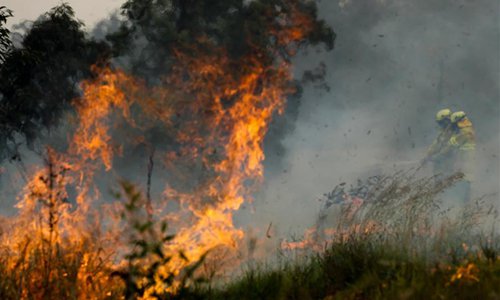HOME >> WORLD
Bushfire bears down on major Sydney tourist attraction
Source:Xinhua Published: 2019/12/2 14:05:06

Firefighters battle the flames during bushfires near Taree, New South Wales, Australia, Nov. 11, 2019. A devastating start to the Australian bushfire season has prompted a state of emergency in the eastern state of New South Wales (NSW), with the country's largest city, Sydney bracing for "catastrophic" fire danger. On Monday, a state of emergency was declared for NSW, with exceptionally hot and windy conditions predicted for Tuesday, threatening to create an even bigger fire disaster than that which left three people dead last week. (Xinhua/Bai Xuefei)
A giant bushfire is currently bearing down on one of Australia's most iconic tourist attractions Monday, as the country's horror fire season continues to ravage large parts of the east coast.
Situated 100 km west of Sydney, the Blue Mountains' most famed site -- the Three Sisters -- which consists of the Meehni, Wimlah and Gunnedoo peaks, receives around four million visitors every year.
While the lookout is a major hit with international visitors, the spectacular panoramic landscape also holds great spiritual significance for Australia's Indigenous population.
At the moment however, the rugged bushland area is being threatened by out-of-control wildfires which have accelerated overnight due to worsening weather conditions.
"People need to be very attentive today and make sure that they look after themselves," New South Wales (NSW) State Rural Fire Service (RFS) Deputy Commissioner Rob Rogers, told the Today program.
"Tomorrow the winds will ease a little bit, but we are still expecting quite a warm day."
"But then Wednesday will be quite hot and windy. I think that will be looking at the peak of the weather. Beyond that, there's no respite in sight for meaningful rain at all."
Described as the "most challenging bushfire season ever" by Rogers, so far there have been over 7000 blazes in the State which have claimed the lives of six people, and destroyed around 670 homes and 1400 structures.
In total, it's estimated by the NSW RFS that more than two million hectares of grass and bush land have been lost since July.
Posted in: ASIA-PACIFIC,WORLD FOCUS